The Wheelchair Guide
Your Wheelchair and Mobility Scooter Resource
Wheelchair Lifts vs Wheelchair Ramps
Thursday, September 9th, 2010
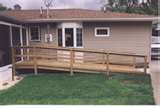 In homes that have a staircase on the front access, it can be very difficult for wheelchair users to safely and conveniently get into and out of their home. There are a number of options available to help make this task easier, but in most cases, the wheelchair lift is the most effective and safest type of home mobility aid.
In homes that have a staircase on the front access, it can be very difficult for wheelchair users to safely and conveniently get into and out of their home. There are a number of options available to help make this task easier, but in most cases, the wheelchair lift is the most effective and safest type of home mobility aid.
Wheelchair Ramps
Traditionally, wheelchair ramps have been used to allow full access to a home. These are commonly seen on commercial buildings and often on homes as well. For non-commercial use, the most common type of wheelchair ramp is the wooden one, which is made in a manner similar to building a deck. There are a number of wheelchair ramp plans available and most capable contractors or handymen can build one, with most areas having companies that also specialize in custom wheelchair ramps. Generally, if you would not feel comfortable building your own deck, it is not a good idea to build a wooden wheelchair ramp.
In addition to wooden ramps, there are a number of pre-made metal ramps. Some of these are simple metal planks or threshold ramps, which are mainly used when there is only a step or two that must be navigated. For larger staircases, modular metal ramps are available, which come in sections and can be fitted together very easily.
While wheelchair ramps, at least wooden wheelchair ramps, are usually a good deal less expensive than a wheelchair lift, they can take up a lot of space. In the case of wooden ramps or modular ramps, it is not common for a significant amount of the front yard to be taken up by the wheelchair ramp. Smaller ramps, which are used when there is just a step or two, can make regular use of the staircase more difficult.
Wheelchair Lifts
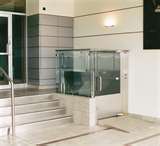 Wheelchair lifts are usually a more expensive option than building your own wooden wheelchair ramp, although modular -metal wheelchair ramps can get much more expensive and are often similar cost to a wheelchair lift. However, the added cost comes with a great deal more convenience and flexibility.
Wheelchair lifts are usually a more expensive option than building your own wooden wheelchair ramp, although modular -metal wheelchair ramps can get much more expensive and are often similar cost to a wheelchair lift. However, the added cost comes with a great deal more convenience and flexibility.
Wheelchair lifts, or vertical platform lifts, are basically a completely self-contained elevator unit, which is placed next to a staircase. Since the vertical platform lift is self-contained, there is no need to modify the home, such as you would need to do when building a residential elevator. Instead, the wheelchair lift can be placed directly next to the staircase and used to lift the user safely and quickly to the landing.
The biggest concern with an outdoor wheelchair lift is that the base that the unit sits on is well made and provides adequate drainage. A concrete base works best, although a wooden base can also be used, providing it is sturdy enough to support the weight of the vertical platform lift and its occupants.
It is also very important to consider things like overhanging branches, which could fall on the lift during a storm and damage it, as well as roof water run-off. In the case of the latter, it is very important that gutters are installed above the wheelchair lift and that ground water can not build up around the base of the device.
In addition to being easier to use, wheelchair lifts are installed on the side of a staircase, next to the landing. This means that full access to the steps will be maintained, with no obstructions.
Wheelchair Lifts and Interior Staircases
On interior staircases, a wheelchair lift is not always an option, as the lift must be installed next to the staircase’s landing. This is one of the reasons vertical platform lifts are often called “porch lifts,” as they are most often used on the front porch of a home.
For interior staircases, an inclined platform lift can sometimes be used, which provides a platform that moves along the length of the staircase, instead of vertically. These take up a lot of space though, so are more common on commercial stairways.
Increasing Wheelchair Accessibility: The Front Steps
Monday, November 23rd, 2009
For wheelchair users, making sure that all areas of a home is accessible is very important, not just to make getting around easy, but also to address safety concerns. In most cases, ensuring a home is wheelchair friendly starts with the front entrance.
Depending on how a home is set up, the front or side door usually presents the first and sometimes only hurdle to a wheelchair user. So, finding a way to safely and cost effectively bridge this gap is very important and largely depends on the type of door in the home.
Most homes have at least one or two steps separating around most entrances, which can present a very big obstacle to those who use wheelchairs.
Small Wheelchair Ramps
If there are only a few steps, installing a small ramp is sometimes the quickest, easiest, and least expensive way of ensuring wheelchair access.
Ramps come in a variety of sizes and designs, both made out of wood and metal. Since the length of a wheelchair ramp is directly proportional to the length of the staircase, the lower the staircase, the shorter the ramp.
If the staircase is only a few feet high, it is usually possible to install a very short ramp, which can be removed or repositioned as necessary. Often, folding metal ramps are used, which are also popular for use with larger vans. If the ramp does not fold, then it is usually made as a single piece, much like a large board of plywood, but much stronger and more rigid.
One of the main advantages of using a short semi-permanent ramp is cost, as these tend to be the least expensive to build or purchase. They can also be quickly removed as needed and typically don’t take up all that much space. However, these types of ramps only work on very short stairways.
For larger staircases, a much longer ramp is needed. Depending on space, this sometimes means creating a zig-zag design, rather than a straight ramp. Usually, as a result of how much longer of a ramp you would need for a larger staircase, installing the ramp on the front of the house is a necessity.
Large Wheelchair Ramps
Like the smaller ramps, it is possible to go with a metal or wooden design. The wooden design is popular, as the materials to build a wheelchair ramp are not very expensive, so if you know someone who is handy, building your own wheelchair ramp is often the best choice from a monetary standpoint. Metal wheelchair ramps are also available and come in sections, making it a modular wheelchair ramp. The number of sections varies by the height of the steps and installing the ramp is simply a matter of connecting the individual sections.
Wheelchair ramps are popular as they do not require any electricity to use and usually don’t have any moving parts, so there are few points that could fail. In most cases, providing the proper type of wood is used and faulty boards are replaced as needed, a wooden wheelchair ramp will last as long as needed.
However, wheelchair ramps do require that the user is able to move themselves along the ramp and depending on the height of the staircase, they can take up a great deal of yard space.
Wheelchair Lifts
Wheelchair lifts or, as they are typically referred to in the industry, vertical platform lifts, represent one of the easiest and safest ways of increasing staircase accessibility. For all intensive purposes, a vertical platform lift is simply a self-contained elevator. Unlike the type of elevators you would see inside of a building, wheelchair lifts do not require a large shaft in the home or much modification to the home. Instead, wheelchair lifts need only be placed next to the staircase landing on a strong surface made out of wood or concrete.
To use a wheelchair lift, the user simply drives their wheelchair onto its platform and activates the call buttons. The platform than lowers or rises the distance of the staircase. One of the advantages of a wheelchair lift is that it can be used easily and requires very little effort on the part of the wheelchair user or caretaker. Simply pushing a button is all it takes to make the stairs safer. Wheelchair lifts also do not take up much front yard space.
However, wheelchair lifts represent the most expensive option, costing significantly more than building your own wheelchair ramp.
How to Transport a Wheelchair
Monday, November 2nd, 2009
As a result of the ADA and other legislation, many of the areas a wheelchair user wishes to go are made accessible. There are of course exceptions to the rule, but the overwhelming majority of businesses in the United States are wheelchair accessible. As a result, the most difficult part of using a wheelchair in public is generally getting it where you need it to be or transporting the wheelchair.
There are a number of different methods to transport a wheelchair, but often the most effective means is to use a vehicle wheelchair lift. Without a vehicle wheelchair lift, however, it is often still possible to transport a wheelchair.
Transporting the Wheelchair in the Trunk or Backseat
 Depending on the type of wheelchair, it is sometimes possible to simply store the wheelchair in the trunk of the vehicle or even in the back seat. This is easiest with manual wheelchairs, which are designed to be folded up when not in use.
Depending on the type of wheelchair, it is sometimes possible to simply store the wheelchair in the trunk of the vehicle or even in the back seat. This is easiest with manual wheelchairs, which are designed to be folded up when not in use.
Some electric wheelchairs and mobility scooters are also designed to be transported easily without a wheelchair lift. These mobility vehicles are usually called travel wheelchairs or travel scooters and are made to be taken apart easily, with no one piece weighing too much for a person to safely lift into their trunk. One drawback to this type of electric power chair or scooter, however, is that in order to reduce weight, a number of features are removed that are in other standard electric wheelchairs.
Using a Van Ramp
 Another option for transporting a wheelchair is to use a ramp system. There are a number of metal folding ramps available, which are designed to be used with the side door of a van. These allow the wheelchair to be driven directly into the van or to be operated by someone standing next to the wheelchair.
Another option for transporting a wheelchair is to use a ramp system. There are a number of metal folding ramps available, which are designed to be used with the side door of a van. These allow the wheelchair to be driven directly into the van or to be operated by someone standing next to the wheelchair.
While it is possible to use a ramp with other types of vehicles, this option works best with vans that have had at least one row of seats removed.
Ramps offer a cost effective wheelchair transport solution, but do not work with all vehicles and unless someone is there to help position the ramp, they can be difficult to use.
Using a Wheelchair Lift
Wheelchair lifts are more expensive than using a ramp, but are much easier to use independently. There are a number of wheelchair lift designs, but they can be broken down into interior wheelchair lifts and exterior wheelchair lift.
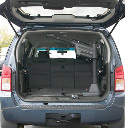 Interior wheelchair lifts are installed inside of the vehicle and store the wheelchair inside as well. There are a few different designs, but most either use a platform lift system or a crane lift system. The platform lift system allows the user to drive their wheelchair onto a small platform that extends from the vehicle. Then, once activated, the wheelchair lift will move the platform and wheelchair inside of the vehicle. You will often see this type of wheelchair lift in vans, but they can also be used in trucks and SUVs.
Interior wheelchair lifts are installed inside of the vehicle and store the wheelchair inside as well. There are a few different designs, but most either use a platform lift system or a crane lift system. The platform lift system allows the user to drive their wheelchair onto a small platform that extends from the vehicle. Then, once activated, the wheelchair lift will move the platform and wheelchair inside of the vehicle. You will often see this type of wheelchair lift in vans, but they can also be used in trucks and SUVs.
The other type of interior wheelchair lift is the crane lift, which is basically just a crane that attaches to the wheelchair and the raises it into the vehicle. Crane lifts can not be used with someone sitting on the wheelchair and it is sometimes necessary to partially disassemble the wheelchair before moving it into the vehicle.
One of the advantages of crane lifts is that they don’t take up much space, so they can be used in a car, where other wheelchair lifts would not work. A nice feature when shopping for a crane wheelchair lift is powered rotation, which means that the arm of the crane can be swiveled using a hand control. This makes it easier to swing the wheelchair into position.
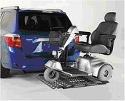 Exterior wheelchair lifts, on the other hand, almost always use a platform lift system, except unlike interior wheelchair lift, the wheelchair is stored outside of the vehicle. Exterior wheelchair lifts attach to the hitch of a vehicle, which means that they are very easy to install, don’t require modification to the vehicle, and do not take up any interior space.
Exterior wheelchair lifts, on the other hand, almost always use a platform lift system, except unlike interior wheelchair lift, the wheelchair is stored outside of the vehicle. Exterior wheelchair lifts attach to the hitch of a vehicle, which means that they are very easy to install, don’t require modification to the vehicle, and do not take up any interior space.
Vertical Platform Lifts and Wheelchair Ramps
Thursday, September 24th, 2009
There are usually some areas with limited wheelchair accessibility that wheelchair users must face when away from home, but there is no reason that any area in your own home should not be wheelchair accessible. Yet, for many this is something that must be faced, with narrow doorways often being a problem.
Another, perhaps even more important obstacle, is the front staircases that adorns most homes. For many wheelchair users, the first step in making their home more wheelchair friendly is to find a way to easily use the front porch.
There are two ways that the front porch is usually made wheelchair accessible, namely by installing a wheelchair ramp or a wheelchair lift.
Wheelchair Ramps
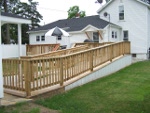 Wheelchair ramps are very common and are often built out of wood by the homeowner. There are a number of free wheelchair ramp plans, which can provide an easy way to increase accessibility. Going the wooden wheelchair ramp route is often the least expensive option and allows the homeowner to custom fit the wheelchair ramp to their yard.
Wheelchair ramps are very common and are often built out of wood by the homeowner. There are a number of free wheelchair ramp plans, which can provide an easy way to increase accessibility. Going the wooden wheelchair ramp route is often the least expensive option and allows the homeowner to custom fit the wheelchair ramp to their yard.
Another option is to use a prefabricated modular wheelchair ramp system. These systems are made out of metal and come in short sections, which are then securely bolted together. The height of the staircase, as well as how many bends are needed in the ramp, determine how many sections are needed. Many people prefer the shiny metal look of modular wheelchair ramps, which are also more weather resistant than wooden wheelchair ramps. However, they are a great deal more expensive than building your own wooden wheelchair ramp.
One disadvantage of using a wheelchair ramp is that they can take up a great deal of space in the yard. This depends on how high the front porch is, with a higher front porch requiring a longer wheelchair ramp. In areas where there is a very small front yard, this might mean that most of the space will be taken up by the wheelchair ramp.
Vertical Platform Lifts
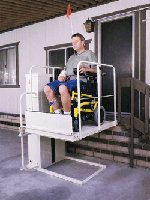 Wheelchair lifts provide a much more low profile solution and are basically mini-elevators. The technical name for a wheelchair lift is a vertical platform lift, which describes how these devices work. The wheelchair lift is placed next to the landing of the front porch, with a platform rising vertically from the ground to the front porch.
Wheelchair lifts provide a much more low profile solution and are basically mini-elevators. The technical name for a wheelchair lift is a vertical platform lift, which describes how these devices work. The wheelchair lift is placed next to the landing of the front porch, with a platform rising vertically from the ground to the front porch.
While vertical platform lifts are similar in concept to an elevator, the entire unit is self-contained, so with the exception of providing a sturdy base for the lift, there is little modification to the structure of the home. The base can be made of wood or concrete, with proper drainage being very important. When considering the placement of the wheelchair lift, it is important to take into account how water drains off the roof, because you do not want it draining directly onto the lift, even though wheelchair lifts are weather resistant.
The main advantage of a vertical platform lift, other than the small amount of space it takes up, is that it provides a virtually effortless means of entering the house. The user need only drive their wheelchair onto the platform and push a button, with the lift doing the rest of the work.
From a cost perspective, vertical platform lifts do usually cost considerably more than wooden wheelchair ramps. However, with the high price of modular metal wheelchair ramps, there is not always as large of a price difference between wheelchair lifts and metal wheelchair ramps.
Increasing Accessibility With Wheelchair Ramps and Vertical Platform Lifts
Friday, September 18th, 2009
One of the most common dilemmas faced by those who use wheelchairs and mobility scooters is how to safely and easily move these devices into and out of the home. There are several popular options, which include installing a wheelchair ramp or using a vertical platform lift.
Wooden Wheelchair Ramps
 Wheelchair ramps are often found in commercial settings made out of poured concrete, but they are also popular in residential settings. For use in homes, the concrete wheelchair lift is not as popular though, with most people using a wooden wheelchair ramp or a modular metal wheelchair ramp.
Wheelchair ramps are often found in commercial settings made out of poured concrete, but they are also popular in residential settings. For use in homes, the concrete wheelchair lift is not as popular though, with most people using a wooden wheelchair ramp or a modular metal wheelchair ramp.
In the case of wooden ramps, a number of plans are available, which can built by those who are reasonably handy with tools and knowledgeable with woodwork. There are usually a number of local handymen who can be hired to build a wooden wheelchair ramp as well.
It is important to invest in quality treated lumber, which will be able to withstand water and the elements. While a wooden wheelchair ramp is usually less expensive, the lumber and other building supplies can quickly add up.
Modular Metal Wheelchair Ramps
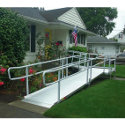 Modular metal ramps are also popular, as they only need to be fitted together at the home, greatly reducing the installation time and cost. However, a modular metal ramp typically costs a good deal more than it would cost to build a wooden wheelchair ramp. It is more durable though and many like the shiny metal look over the wooden feel offered by a wooden wheelchair ramp.
Modular metal ramps are also popular, as they only need to be fitted together at the home, greatly reducing the installation time and cost. However, a modular metal ramp typically costs a good deal more than it would cost to build a wooden wheelchair ramp. It is more durable though and many like the shiny metal look over the wooden feel offered by a wooden wheelchair ramp.
Threshold Ramps
When deciding what type of ramp to purchase, it is important to consider whether a full ramp is needed or simply a threshold ramp. For very short distances, a threshold ramp can be a very cost effective type of wheelchair ramp, which is basically a metal plank that attaches to the door frame and can usually bridge a few steps. However, a threshold ramp will only work on very short distances.
Drawbacks of Using a Wheelchair Ramp
While wheelchair ramps can be cost effective, they have two major drawbacks. One is the amount of space they take up in the yard. The length of the ramp is directly related to the height of the staircase, so in many cases, a wheelchair ramp will have to be very long, taking up a good deal of real estate on the lawn. Not only can this be a drawback when it comes to how the home looks, but for those with animals or small children, this loss of yard space can greatly affect how the home is used.
The other main drawback is that even though the incline is not very large, you still must move the wheelchair up what is essentially a hill when you use a wheelchair ramp. In the case of some older wheelchair users and those who use manual wheelchairs, this might not be possible. Even if you have someone to push the person up the ramp, it can require a great deal of effort and there are some risks associated with wheelchair ramps.
Vertical Platform Lifts
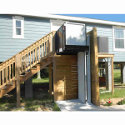 Another option for those who use mobility vehicles, like wheelchairs and electric scooters, is the vertical platform lift. Vertical platform lifts are also called wheelchair lifts and provide what is essentially a mini-elevator that is installed next to the front steps. A metal platform, of varying size, is provided for the wheelchair user to drive onto. When activated, the platform rises upwards until it is parallel with the front steps.
Another option for those who use mobility vehicles, like wheelchairs and electric scooters, is the vertical platform lift. Vertical platform lifts are also called wheelchair lifts and provide what is essentially a mini-elevator that is installed next to the front steps. A metal platform, of varying size, is provided for the wheelchair user to drive onto. When activated, the platform rises upwards until it is parallel with the front steps.
While in functionality a wheelchair lift is very similar to an elevator, the entire unit is self contained, so there is no need to build an elevator shaft or worry about running any cables. Instead, once the wheelchair lift is assembled, it can simply be placed where it is needed and turned on, instantly bridging the gap between the ground and the front steps.
These devices are also called porch lifts, because they are usually used on the front porch of a home, but they are also popular in schools and other commercial buildings.
Porch lifts include a number of safety settings, with doors available for both the top and bottom of the staircase. This can be important, because to install a porch lift it is usually necessary to remove a section of the handrail at the top of the landing. A door with call button at the top of the landing can serve as a gate, preventing falls when the porch lift is at the bottom of the staircase.
Vertical platform lifts are very popular because they are easy to install and do not take up much space. As a result, they can be used in many areas where a wheelchair ramp would not fit or would take up too much yard space. These wheelchair lifts are also quite powerful, with most supporting around 700 pounds and can span distances of up to 12 feet. In some cases where the porch is very high off the ground, the amount of space required to make a wheelchair ramp would be very excessive, where using a wheelchair lift requires only a few feet.
Due to their weight capacity, wheelchair lifts can also be used as service elevators, making moving heavy objects up the stairs much easier. It is also not uncommon for two people to use the porch lift at once, with one in a wheelchair or mobility scooter and the other behind them.
Wheelchair lifts do, however, cost more than most wheelchair ramps, although this is not always the case with modular metal wheelchair ramps, which can end up being pretty expensive as well.
Vertical Platform Lifts vs Wheelchair Ramps
Tuesday, July 21st, 2009
For those that use wheelchairs, the stairs can present an obstacle that is very difficult to overcome. In some cases, it is possible to simply avoid traveling in areas that have stairs. However, around the home simply avoiding the stairs is typically neither practical or possible. There are several options to help make a homes staircase more accessible, but most people either install a vertical platform lift or a wheelchair ramp. Both of these options have their own advantages and disadvantages, which should be carefully weighed when making a home accessible.
Vertical Platform Lifts
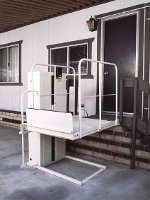 Vertical platform lifts are one of the most efficient ways of allowing a wheelchair user to travel over the stairs. Vertical platform lifts, which are often referred to as wheelchair lifts, are basically like a self contained elevator. The lifting platform, motor, and elevator shaft are all contained in a single unit, which can be placed next to a staircase to improve accessibility. The lifting height varies by model, but most have a default lifting height of around four feet, which can then be upgraded to about twelve feet.
Vertical platform lifts are one of the most efficient ways of allowing a wheelchair user to travel over the stairs. Vertical platform lifts, which are often referred to as wheelchair lifts, are basically like a self contained elevator. The lifting platform, motor, and elevator shaft are all contained in a single unit, which can be placed next to a staircase to improve accessibility. The lifting height varies by model, but most have a default lifting height of around four feet, which can then be upgraded to about twelve feet.
Vertical platform lifts are plugged into a normal electrical outlet and provide a platform for the user to drive their wheelchair onto. Then, the platform can be raised and lowered to allow full access to the home. Some wheelchair lifts include locking gates, both on the lifting platform itself, as well as at the top of the staircase landing to increase safety. Locks are also available, which may be required for commercial wheelchair lifts.
Usually the weight capacity of a vertical platform lift is at least 500 pounds, although some can support more than this. It is possible for more than one person to use the wheelchair lift at once, providing this does not exceed the weight capacity. They can also be used to move boxes or other items up and down the stairs.
Vertical platform lifts require a strong base that can support the weight of the lift, as well as the weight of the people using it. The base can be made from concrete or wood, providing it is sufficient to support the weight and stable.
The cost of a vertical platform lift varies, but usually they cost between $3,500 and $11,000. The installation of a vertical platform lift is straightforward and not very difficult, but the unit itself can be very heavy, so getting it in place may be difficult for some.
Wheelchair Ramps
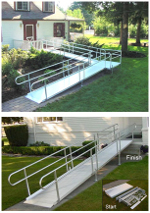 Installing a wheelchair ramp will often be a lower cost alternative to a wheelchair lift. Ramps can be custom made out of wood or metal ramp kits can be bought and assembled. The metal ramp kits typically come in sections, which are assembled at the home, and are referred to as modular wheelchair ramps. The height of the staircase will determine how many sections are needed. In some cases, modular wheelchair ramp kits can prove to be just as expensive as a wheelchair lift.
Installing a wheelchair ramp will often be a lower cost alternative to a wheelchair lift. Ramps can be custom made out of wood or metal ramp kits can be bought and assembled. The metal ramp kits typically come in sections, which are assembled at the home, and are referred to as modular wheelchair ramps. The height of the staircase will determine how many sections are needed. In some cases, modular wheelchair ramp kits can prove to be just as expensive as a wheelchair lift.
Wheelchair ramps offer the advantage of not requiring any electricity to function and since there are no moving parts, there is little about the ramp that can break. However, wheelchair ramps can take up a lot of space in a persons yard and the higher the staircase, the more space they will take up. Using a ramp can also prove to be very strenuous for those who use a manual wheelchair.
When choosing between a wheelchair ramp and a vertical platform lift, it is important to consider the location where the accessibility aid will be installed, as well as the condition of the person who will be using the device. However, for small staircases, which consist of only a step or two, there are a number of threshold ramps available that will be much more practical than a wheelchair lift would be.
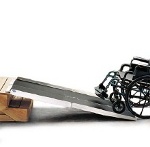 For very short staircases, of only a few steps, a simple metal ramp is the easiest and least expensive option. These come in a variety of designs, but are usually between 3′ and 6′ long. The ramp, which is made out of lightweight metal and usually has a non-skid textured backing, is simply placed onto the landing of the staircase, with some offering lightweight clamps that help hold the ramp in place. The wheelchair user can then drive up or down the ramp, which can be set up or removed in minutes.
For very short staircases, of only a few steps, a simple metal ramp is the easiest and least expensive option. These come in a variety of designs, but are usually between 3′ and 6′ long. The ramp, which is made out of lightweight metal and usually has a non-skid textured backing, is simply placed onto the landing of the staircase, with some offering lightweight clamps that help hold the ramp in place. The wheelchair user can then drive up or down the ramp, which can be set up or removed in minutes.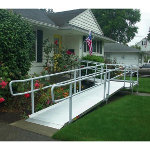 For larger staircases, a much larger wheelchair ramp is required. These often are custom built out of wood, with many free wheelchair ramp plans available online. Wooden wheelchair ramps are usually a fairly cost effective option and can be built by most handymen. It is also usually possible to hire most carpenters to build a wooden wheelchair ramp.
For larger staircases, a much larger wheelchair ramp is required. These often are custom built out of wood, with many free wheelchair ramp plans available online. Wooden wheelchair ramps are usually a fairly cost effective option and can be built by most handymen. It is also usually possible to hire most carpenters to build a wooden wheelchair ramp. 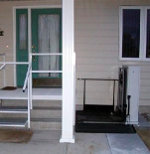 Wheelchair lifts are also a popular choice for those who use mobility scooters and electric wheelchairs, with these devices being very similar to an elevator in the way they work. The wheelchair lift, which is referred to as a vertical platform lift in the home medical industry, is placed next to the landing of the staircase, raising and lowering the wheelchair user on a metal platform.
Wheelchair lifts are also a popular choice for those who use mobility scooters and electric wheelchairs, with these devices being very similar to an elevator in the way they work. The wheelchair lift, which is referred to as a vertical platform lift in the home medical industry, is placed next to the landing of the staircase, raising and lowering the wheelchair user on a metal platform.